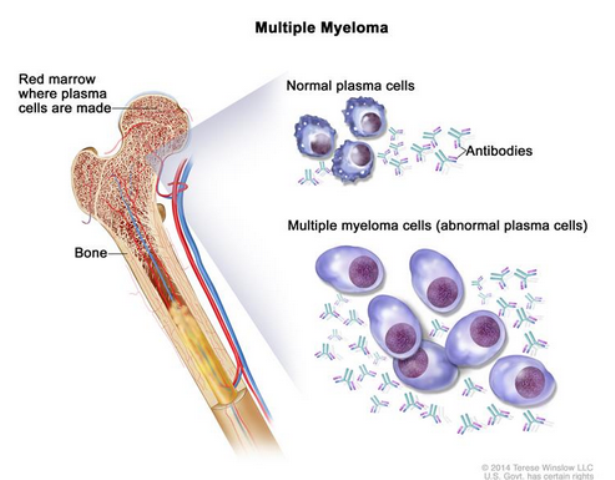FDA Approves Panobinostat for Some Patients with Multiple Myeloma
, by NCI Staff
The Food and Drug Administration (FDA) has granted accelerated approval of panobinostat (Farydak) for the treatment of patients with multiple myeloma whose cancer has progressed after treatment with at least two prior standard therapies. Panobinostat is a type of drug called a histone deacetylase (HDAC) inhibitor. The approval is for use of panobinostat in combination with bortezomib (Velcade) and dexamethasone.
The approval was based on the findings in a subgroup of 193 patients who participated in a clinical trial called PANORAMA1. Patients in the trial had myeloma that had returned after prior treatment or that did not respond to treatment after a recurrence; they were randomly assigned to receive a combination of panobinostat, bortezomib, and dexamethasone or bortezomib and dexamethasone alone.
The patient subgroup on which the approval was based had received at least two prior treatments, including bortezomib and an immunomodulatory drug, such as lenalidomide (Revlimid). Among these 193 patients, median progression-free survival was 10.6 months in those who received panobinostat and 5.8 months in those who received bortezomib and dexamethasone alone. Moreover, 59 percent of the panobinostat-treated patients in this group had a tumor response—that is, their cancer shrank or disappeared after treatment—compared with 41 percent of those receiving bortezomib and dexamethasone.
Nearly all patients treated with panobinostat (96 percent) experienced a grade 3/4 adverse event, with 60 percent experiencing a serious adverse event. The most common adverse events included nausea, vomiting, diarrhea and fatigue. More than one-third of patients in the study discontinued treatment due to an adverse event.
Panobinostat is the first HDAC inhibitor approved for the treatment of multiple myeloma. (Two other HDAC inhibitors have been approved for the treatment of some patients with cutaneous T-cell lymphoma.)
“Multiple myeloma is not as responsive to traditional chemotherapy drugs as other hematologic malignancies,” said Mark Roschewski, M.D., of the Lymphoid Malignancies Branch in NCI’s Center for Cancer Research. “Over the last 10-15 years, novel classes of drugs have become available that are effective against multiple myeloma. Now most patients receive these drugs at some point in their treatment course, but no combination of drugs has proven to be curative.”
“There is a need for drugs with novel mechanisms of action for patients with myeloma,” said Sham Mailankody, MBBS, also of the Lymphoid Malignancies Branch. In preclinical and early-phase clinical trials, Dr. Mailankody explained, panobinostat and other HDAC inhibitors improved the efficacy of proteasome inhibitors like bortezomib.
“This approval provides an additional treatment option for patients with relapsed or refractory myeloma,” he said.
Panobinostat was approved with a Risk Evaluation and Mitigation Strategy (REMS), which requires the drug’s manufacturer, Novartis, to implement a communication plan to inform health care professionals of risks associated with taking this drug and how to minimize them. The panobinostat label includes a black box warning for severe diarrhea and severe and fatal cardiac events.
“Given the modest improvement seen to this point, patients should be aware of the toxicity of this drug,” said Dr. Roschewski.
